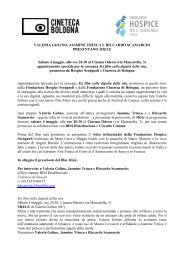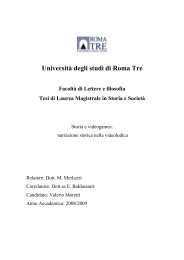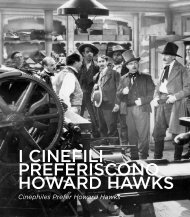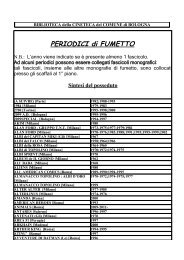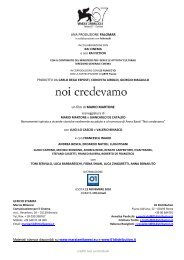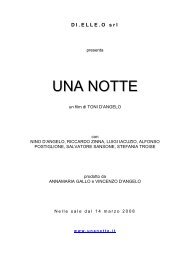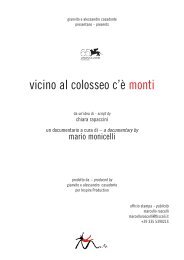Catalogo 1999 - Cineteca di Bologna
Catalogo 1999 - Cineteca di Bologna
Catalogo 1999 - Cineteca di Bologna
Create successful ePaper yourself
Turn your PDF publications into a flip-book with our unique Google optimized e-Paper software.
Due delle tre<strong>di</strong>ci bande presentate sono nettamente più lunghe delle altre, e il movimento stu<strong>di</strong>ato sembra meno evidente. Questi<br />
due “Fucili cronofotografici” si svolgono solo una volta, perfettamente leggibili a causa della loro lunghezza. L’uomo che<br />
raccoglie il suo cappello è libero, dopo questo gesto unico, <strong>di</strong> uscire dall’inquadratura e <strong>di</strong> andare dove gli pare. La finzione può<br />
ormai installarsi... (Clau<strong>di</strong>ne Kaufmann)<br />
From 1966, the Cinémathèque Française began restoring some of Etienne-Jules Marey’s chronophotographic<br />
tracks that had been conserved in his collection. The operation deals with about 400 little<br />
rolls of thin nitrate film recorded between 1890 and 1895, mostly negatives, 9 centimeters wide and<br />
one meter long, each containing about fifteen images. They are all mostly negatives with a very fragile<br />
backing, in an unreproducible format, these mythic images are practically untouchable and invisible in<br />
their current state.<br />
The Cinémathèque Française’s decision to use the <strong>di</strong>gital technique to restore this material should perhaps be rationalized, the<br />
process no longer implies a 35mm film transfer, but a special treatment and eventual transformation of the image itself.<br />
Paradoxically, the first operation consists of an attempt to immobilize part of the image, as though dealing with the reluctance of<br />
a very sick man. In effect, the <strong>di</strong>gital process allows for the correction of camera unstea<strong>di</strong>ness, mitigating the viewing <strong>di</strong>scomfort<br />
thus provoked. But this correction, if it is eccessive, can become equally <strong>di</strong>spleasing to the spectator, involving the immobilization<br />
of the background in a fixed image for a matter of seconds. In this case, the horizon line freezes, the leaves on the trees stop<br />
trembling, the white tent loses its undulating reflection. The patient has healed, but has <strong>di</strong>ed in the process and even been<br />
embalmed. The subjects in motion (the man that runs, the horse that jumps) seem incongruous, like estraneous bo<strong>di</strong>es<br />
transparently emblazoned onto a filmed décor. They <strong>di</strong>sturb the perfection of the immobility. “I hate movement that moves the<br />
lines...” Verlaine always used to say.<br />
To integrate, by means of a simple cut and paste technique, gaps in the emulsion or to eliminate the<br />
scratches on the film’s backing can lead to the complete suppression of the signs left by time: the time<br />
of the film, like that of the spectator, testifies in anguish for the abolition of duration, and of the<br />
perverse effects of an eternal youth elixir. And yet, the <strong>di</strong>gital technique also permits us to keep tabs on<br />
the <strong>di</strong>fferent stages of the completed work: the actual state of the restoration of these chronophotographic<br />
tracks is perhaps not definitive, and repentance is still possible.<br />
The 35mm transfer and the 24 f/s projection implies a necessary repetition of the tracks and a<br />
multiplication of some of the images. In effect, the fifteen frames constituting each track would be<br />
illegible to our perception without this lengthening. Here lies the true betrayal without a doubt in<br />
comparison with Marey: to invest these hypnotically charged images generated by the repetition of the<br />
same object with an artificially prolonged period of time. If the subject effects a <strong>di</strong>splacement in space<br />
(like the cat that walks, or the black horse that jumps), vanishing on the right side of the frame to<br />
imme<strong>di</strong>ately reappear on the left side restarting its brief trajectory. Time does not stop, it slides and<br />
falters. If the subject remains in the same place (one hand that opens and closes; Georges Demeny,<br />
with the expression of a somnambulist, eyes closed, repeating strange phrases like “Vous m’y<br />
poussez”, or “Le plus beau mur”) it fatigues us to trace the joint between the last images of the track<br />
and the first images of its repetition. The sensation of a litany persists almost enchantedly, it has a<br />
circulatory effect, of the closure of time upon itself. Thus, giving a “naturalist” link back to the<br />
movement, the 35mm projection produces the magic of an irreal time and the fascination of an eternal<br />
return.<br />
Two of the presented tracks are clearly longer than the others, and the stu<strong>di</strong>ed movement seems less<br />
evident. These two “chrono-photographic rifles” unfold before our eyes only once, perfectly legible<br />
due to their length. The man that collects his hat is free, after this unique gesture, to exit from the frame<br />
and to go wherever he pleases. By now fiction can impose itself... (Clau<strong>di</strong>ne Kaufmann)



